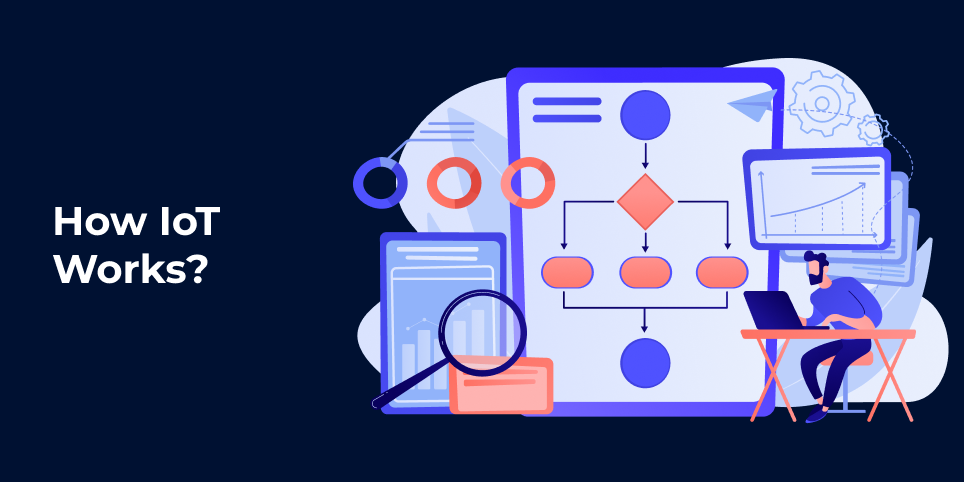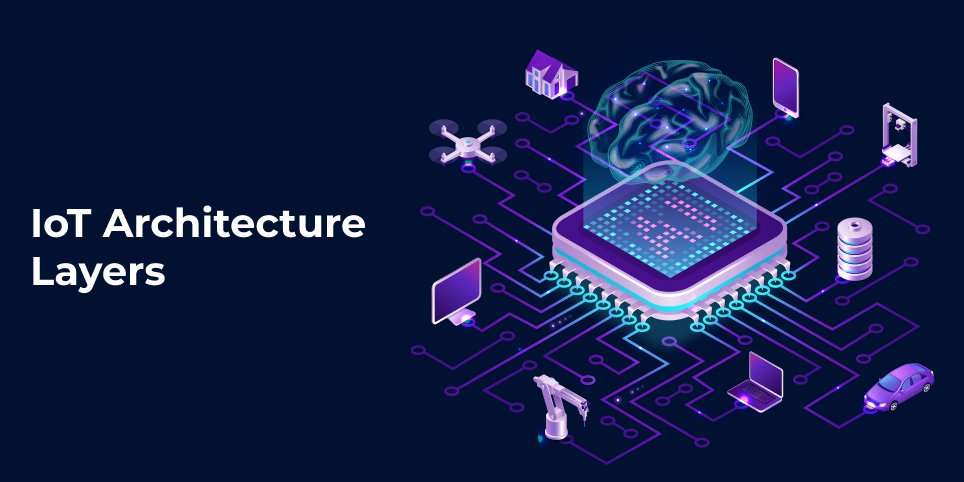
Internet of Things Architecture- The Pathway from the Physical Signals to the Business Decisions
Doesn’t it feel great imagining a huge number of smart devices under the centralized control of just a single brain? This is possible with the evolution of the Internet of Things. IoT solutions are an integral part of everybody’s lives. From the smartwatch you are wearing on your wrist to the industrial enterprises, there are connected devices everywhere. You get immediate results when you say a word or tap your smartphone’s screen. To have things work for us is not a sci-fi fantasy anymore. The network of the physical objects having actuators and sensors and network and software connectivity enables the objects to gather and transmit data and fulfill the users’ tasks.
Between your command and the fulfillment of tasks, there exists a mostly invisible but large infrastructure that involves multiple interactions and elements. The applicability and effectiveness of such a system correlate with the quality of the building blocks directly and how they interact. There exist different approaches to the IoT infrastructure. This article will describe IoT through its building blocks and architecture and explain how it works.
Basic elements of the architecture of IoT

IoT might seem to be an emerging tech, but in reality, it is a bridge between the digital and physical world. You must be astonished to know that the first IoT device at Carnegie Mellon was a soda machine. It led to the development of the foremost extensively used IoT device- ATMs. The architecture of IoT comprises various IoT system building blocks that are connected to ensure that the device data that are sensor generated are firstly collected, then stored, and finally processed in the warehouse of big data. The actuators of devices perform commands that are sent through a user application.
Things : Sensors are the front end of an IoT device and are also referred to as “Things”. These objects are equipped with sensors to gather data that can be transferred across actuators and a network that makes things work. This may include switching on the light, opening and closing the door, and increasing and decreasing the engine’s rotation speed. In all cases, sensors may not be physically attached to the things and will need to be monitored.
Gateways : Through the gateways, the day moves from the things to the cloud, and conversely. Gateway offers connectivity between the cloud part and things of the IoT solutions and enables data filtering and monitoring. It also transmits the control commands moving from the cloud to the things.
Cloud gateways : This facilitates secure data transmission and compression between the cloud IoT servers and the field gateways. It also guarantees compatibility with different protocols and connects with the field gateways using various protocols.
Steaming data processors : These are the brain of an IoT system. The main function of the processors is to process the data captured by the sensors and then process them for extracting valuable data from a large amount of the collected raw data. This certifies effective input data transmission to the control applications and the data lake. So, no data is corrupted or lost. We can define it by saying it provides intelligence to the data. These processors mainly work based on real-time and can easily be controlled by the applications. Also, these are held responsible for securing the data that perform data decryption and encryption.
Data Lake : It is used to store the data generated by the connected device in its usual format. The big data arrives in streams or batches. When the data is required for meaningful insights, it is extracted from the data lake and then loaded into the big data warehouse.
Big data warehouse : The big data warehouse comprises only matched, structured, and cleaned data. The warehouses also store context information regarding sensors and things and applications of command control sent to the things.
Data analytics : Data from the warehouse are used by data analysts to gain actionable insights and find trends. When analyzed, the big data identifies the inefficiencies, shows the performance of the devices, and works out various ways to improve the IoT systems.
Machine Learning and its models : ML helps create more efficient and precise models for control applications. Based on the historical data that is accumulated in the warehouse, models are updated regularly. When the efficiency and applicability of the new models are first tested and then approved by the data analysts, the new models are used by the control applications.
Control applications : It sends alerts and commands to actuators which can be stored in the warehouse. It might help in investigating problematic cases. Store commands from the control apps might contribute to security. The control apps may be machine-learning based or rule-based. The control apps certify better automation of the IoT system.
User applications : These are the software components of the IoT system that enable the users’ connection to the IoT system. It also provides the options to control and monitor their smart things. With the help of a web or mobile app, users can monitor the state of things, send commands for controlling applications and set the choices of automatic behavior.
How IoT works

IoT is experiencing stable growth. This trend is expected to last with the regular growth in the number of devices. It is anticipated that by the end of 2028, the IoT market is likely to grow to $1854.76 billion. The working of IoT is pretty simple. Foremost, it acquires information and data concerning the basic requirements, namely name, addresses, etc. The related traits of the items utilizing automatic perception and identification technology like satellite positioning, wireless sensor, and RFID, the uniquely identifiable “things” or objects, RFID tags, and sensors acquire real-time data with the advantage of the key hub such as smartphones.
Secondly, by the advantages of various types of communication technology, IoT assimilates information related to objects into the network of information and comprehends the integration and intelligent indexing of the data related to the masses of items by resorting to the fundamental resource services. This is the same as the discovery, addressing, and resolution of the internet.
Finally, using intelligent computing technologies like semantic analysis, data mining, fuzzy recognition, and cloud computing, IoT analyses, and processes the data related to the masses of the objects to control the physical world and realize intelligent decisions eventually.
In the physical layer, the data that are collected are moved to the internet devices. Then through the transmission lines such as fiber-optic cable, these moves to the management layer. Here all the data are separately managed from the raw data. All the accomplished information is then released in the application layer to utilize the collected data properly.
IoT architecture layers

Network, Connectivity, sensor layer
This layer consists of sensors and RFID tags that are a vital element of the IoT system and responsible for collecting raw data. This layer also consists of network connectivity such as PAN, WAN, etc., responsible for communicating raw data to the next layer, the Network, and Gateway layer. The devices that are comprised of the WSN have limited storage capacity, small processing speed, and restricted communication bandwidth. There are different sensors for various applications like the water sensor to examine the water quality, the temperature sensor to collect temperature data, and the moisture sensor to measure the moisture content of soil or atmosphere.
Management service layer
This layer is used to manage the IoT services and is responsible for securing the IoT devices, device management, and information analysis. Management of data is necessary for extracting vital information from the huge amount of raw data that is collected by sensor devices to yield a valuable result for every data collected. This layer is also responsible for service analytics, text mining, data mining, etc. The management service consists of Operational Support Services, including device management and configuration, device modeling, and many more. Also, there are billing support system that supports reporting and billing.
Also, there are M2M/IoT application services that include data and analytics platforms, security including identity access management, encryption, access controls, etc., and Business Process Management and Business Rule Management.
Application layer
In the IoT architecture, this layer forms the topmost layer responsible for efficiently utilizing the collected data. Different IoT applications include E-government, E-health, Home Automation, etc. There are two kinds of applications- Sector-wise application that includes transportation, healthcare, energy, etc., and horizontal market includes supply chain, fleet management, etc.
Device Management
As per GSMA Intelligence data, there will be more than 25 billion IoT connections. Data from Cisco says that by 2030, 500 billion devices are projected to be connected to the internet. To ensure sufficient functioning of the IoT devices, some procedures are involved for managing the performance of the connected device.
Device identification : For establishing the identity of a device to ensure that the device is genuine with trusted software that transmits reliable data
Control and Configuration : This is required for tuning devices as per the need of the IoT system. Few parameters must be written when the device is installed, whereas others require updates.
Diagnostic and Monitoring : This is performed to ensure the secure and smooth performance of each device in a particular device and thus helps reduce the breakdown risks.
Maintenance and software updates : This function is performed to address security vulnerabilities, fix bugs, and add functionality
User Management
Last year the total number of users of smartphones topped 6 billion. Australia and Asia are collectively the largest users of individual robots. User management involves the process of identifying the users, ownership, access levels, and their roles. It involves options like managing user settings, removing and adding users, controlling access of different users to particular information and the permission to perform various operations in the system, and recording and controlling user activities.
Security Monitoring
One of the topmost concerns in IoT is Security. The connected things produce data in huge volumes that need to be transmitted securely and protected from cybercriminals. The IoT security market is forecasted to increase to $18.6 billion this year. The endpoint security is predicted to reach over 19 billion by 2025, as per Statista. 63% of the companies say that IT security is a vital skill for IoT. Cybercriminals might get access to the brain of the total IoT and can take control of the system. To prevent such problems, it is important to log and properly analyze the command sent by the control applications to things, monitoring the actions of the users and storing the data in the cloud. Such an approach can help address security breaches very quickly and take proper measures to reduce the influence of the IoT system. It is quite possible first to identify the nature of the suspicious behavior, then store the samples, and then compare them with the logs that are generated by the IoT systems to prevent penetration and minimize their effect on the IoT system.
Wrapping up
By now, you must have understood the trick behind everyday magic. To develop an IoT architecture of a specific solution, it is very important to focus on some vital factors such as consistency i.e., to give enough attention to each element of the IoT architecture, and to make them work together, integrate with the enterprise solutions i.e., to team up innovative IoT solutions with already implemented corporate IT solutions like delivery management, WMS, MES, ERP, and more and flexibility i.e., opportuning of adding new logic and new functions.



